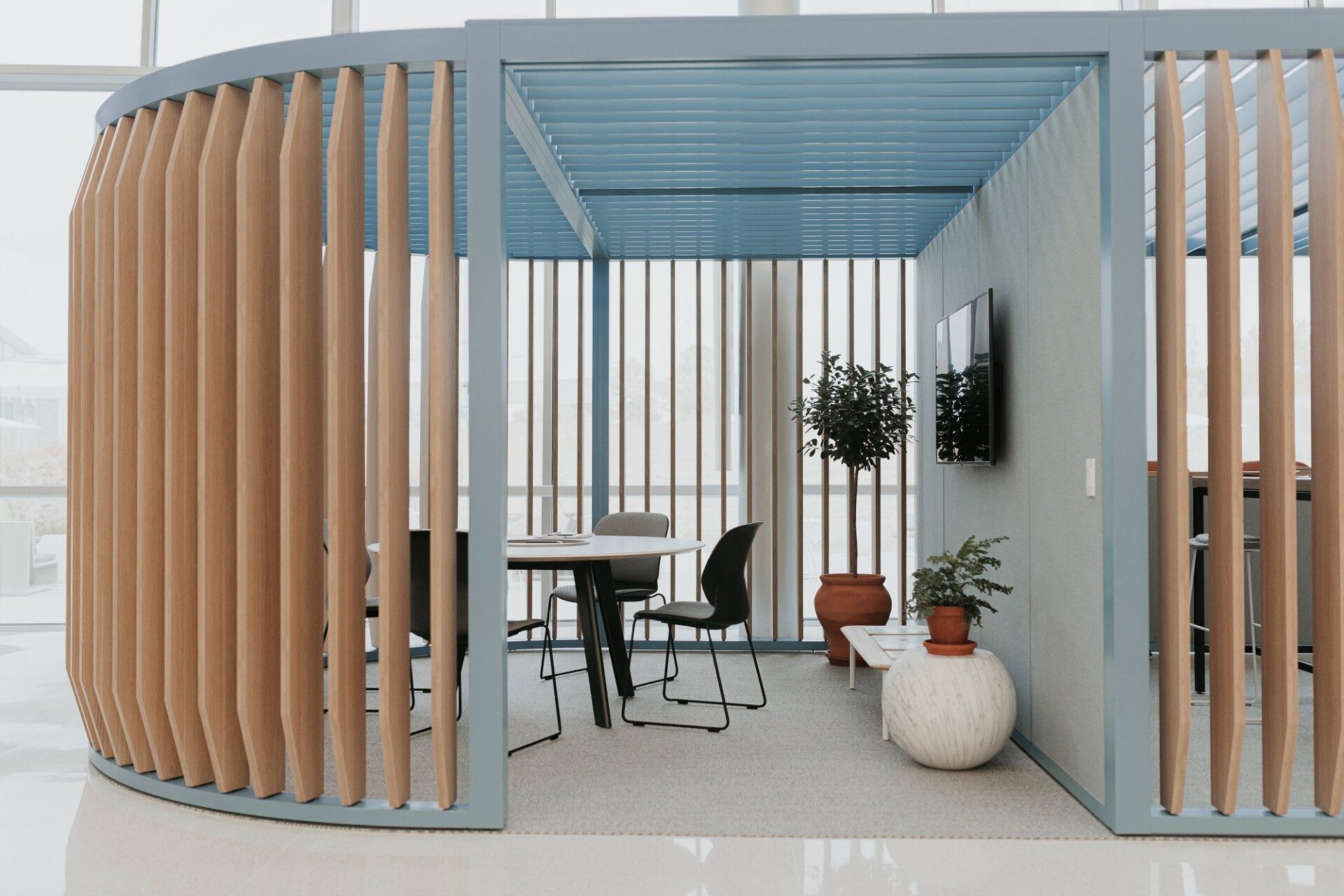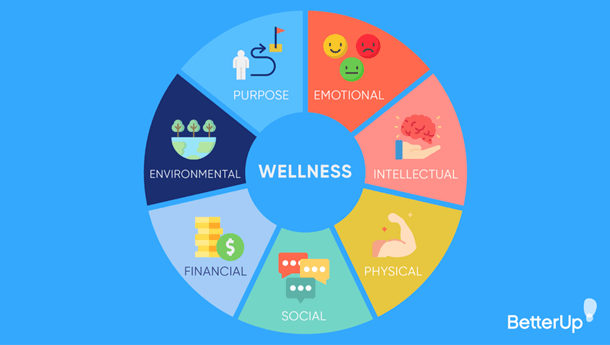-
Products
Browse all productsInspiring WorkspacesWe design, supply and service an extensive range of New Zealand made and imported commercial office furniture.
- Haworth
- Workplace Design
- Our Work
-
About
About
For over 60 years we have used our learning and experience to help create inspiring workspaces throughout Aotearoa. - Find us
-
Products
Browse all productsInspiring WorkspacesWe design, supply and service an extensive range of New Zealand made and imported commercial office furniture.
- Haworth
- Fitout Calculator
- Online store
- Workplace Design
- Our Work
- About
- Blog
- Find us
- CONTACT US
- 0800 43 45 46
The importance of a wellness policy and what to include

What does wellness mean to you? A challenge for many employers in 2022 is providing employee benefits that suit the majority of their team. It can be even more challenging if you operate in a hybrid work model, with some of your team working onsite, and some working from home.
For some employees, wellness might mean a discounted gym membership, or fresh fruit on offer in their shared office kitchen. Others may value access to free mental health counselling, or additional leave or parental leave days to spend time with their young family. No matter what wellness means to you, as an employer or an employee, we’ll tackle some of the key considerations your HR team needs to consider when developing a wellness policy for your business.
What does “WELLNESS” mean?
Traditionally, wellness has been associated with one’s physical health. Being physically fit and healthy is obviously more important in some industries than others. Going back a few generations, highly manual jobs (think agriculture, forestry and primary production) may have required employees to get an annual physical check to ensure they were “up to the job”. Nowadays, physical health is certainly a pillar of any wellness programme or policies, but it is one of many. A focus on wellness has become another element of the future of work.
Today, wellness is generally considered to be made up of multiple dimensions, or pillars. We like to think of employee wellness as encompassing the following core pillars:
- Emotional or mental wellbeing
- Physical wellbeing
- Financial wellbeing
- Intellectual stimulation
- Social stimulation
- Optimal environment
- A sense of purpose
A wellness policy can be quite far reaching, from physical services and amenities within the office, to products and services that employees can access during and outside work. Wellness policies tend to be quite specific to the company, their culture, the work they do and driven by employee needs.
We discussed in a previous blog about managing your workspace, that the roles of traditional HR and Health and Safety teams have evolved to be more focused on Culture and Wellbeing within their businesses. Not only is physical safety important, but the broader needs of employees also need to be met.
For employers, the end goal is productivity and lower staff attrition. To put it simply, a healthy, motivated workforce means that more and better work will be done and less sick days will be taken. Job satisfaction is a key indicator of employee loyalty and in a period known as the Great Resignation, retaining good staff will be key to continuing business growth.
A recent NZ Workplace Wellness Report, commissioned by Southern Cross Health Insurance and BusinessNZ, demonstrated that half of the Kiwi businesses surveyed felt that they played a greater role in their employee’s health and wellbeing in 2020. Despite this, our workforces are feeling stressed and anxious. By focusing on employee wellness, through a wellness policy or programme, employers can actively work with employees to reduce stress, anxiety and workloads – for the benefit of all parties

What should a wellness policy include?
A wellness policy will be specific to your business, your company culture, and the needs of your employees. We highly recommended working closely with your employees to shape what this could look like for your business. If you already have a wellness programme or policy in place, annual reviews with your team are important to ensure that it is still hitting the mark. Analysing data around the uptake of certain elements of the policy should be a good indicator for your senior management team around what is working and what isn’t.
Let’s take a look at how you could build out some of the key wellness pillars in your company.
1. Emotional or mental wellbeing
How open are communication channels in your business? Do your team have regular opportunities to chat with their managers and colleagues about their workload and improving processes and systems? Are people encouraged to share both their challenges and wins with the wider team? Does your team have flexible working arrangements? How do you connect with those employees that work for you remotely?
There is no denying that the ongoing impacts of Covid-19 are creating stress for many Kiwis. Whether it is concern about the health of family members, financial stress or just living with the day-to-day uncertainty of an environment we cannot control. Can your company offer support services to your team such as free counselling, lunchtime yoga for stress relief or encourage walking meetings so everyone gets regular desk breaks and fresh air?
2. Physical wellbeing
Your physical wellbeing relates to your physical health. Do your employees have the freedom to attend medical appointments during their work day, and not have to feel guilty if they call in sick? Can you swap out the fatty, sugar filled morning tea shouts with healthy snacks? Do you encourage active meetings or lunchtime activities to encourage your team to get active during their working day? Can your company offer discounted health insurance to support your team to manage their health? Do you promote a healthy diet in your workplace?
We previously shared our thoughts on movement and wellbeing, and the concept that “sitting is the new smoking”. A great read for the more inactive among us.
3. Financial wellbeing
Financial stress can be one of the worst stressors for your employees to navigate. 2022 is a year in which inflation is rising higher than salary increases. With living costs increasing – think mortgage rates, petrol, groceries, this may be adding financial pressure to your employee households.
How can your company contribute to alleviating this stressor? If salary increases are out of the question this year, are there other financial and non-financial benefits you can offer to sweeten the deal for your employees? Discounted products you may sell, partnerships with other companies to offer discounted products or services to your team, or additional leave days to ease outside work commitments?

4.Intellectual stimulation
Bored employees are a risk for all companies. They may look for another job or spread negative energy amongst your wider team. Look for ways to engage with your team, by considering development pathways for their roles, lunch and learn sessions to learn from other team members and professional development opportunities that they are genuinely interested in. Intellectual stimulation can lead to happier and more loyal team members – a win-win!
5. Social stimulation
For many people, spending 40 hours a week working for your company needs to offer some kind of social stimulation, or they’ll look for it elsewhere. Social stimulation often stems from your company culture. Do you value communication, the sharing of ideas, formal and informal get togethers, collaborative projects, outside of work sports teams or social gatherings?
If your team largely gets on socially, then working together on projects, or having effective meetings will create a more productive workplace.
Social stimulation can be more difficult for companies that are increasingly working online. Online “water cooler” chats are gaining in popularity, where your team has the option to join an informal, organic video meeting intended to replicate those daily office kitchen conversations. Providing people the opportunity to connect and check in on each other’s weekends or work challenges they’re having, can meet your team’s immediate needs for social stimulation.
6. Optimal environment
Are your team working in an optimal physical environment? Workplaces, particularly offices, are no longer spaces with cheap carpet, fluorescent lighting and dubious heating. Today’s workspaces should be spaces that inspire innovation for your team, a place that they want to commute to, a working space with natural light, green spaces, comfortable ergonomic furniture and a mix of quiet workspace and social spaces for meetings and collaboration.
Europlan follows the principles of WELL Building Standards, which means that we have a People First approach to our workspace design. We are committed to creating workspaces that “advance human health and wellbeing” with considered design across the following elements: air, water, nourishment, light, movement, thermal comfort, sound, materials, mind, community and innovation.
7. A sense of purpose
Do you give your team a reason to come to work each day, aside from getting the obvious motivation of getting paid? Are they involved in projects they enjoy? Do they have the opportunity to get involved with building the company culture, and participate in internal projects that make your company a better place to work?
The other important aspect of having a sense of purpose, is feeling that you belong. Are steps actively made to celebrate and welcome the diversity of your wider team, and that everyone’s opinions are welcomed and matter?
How can workplace wellness be impacted by the physical environment we work in?
Ergonomic and sustainable principles are fundamental to a high functioning workspace. From ensuring that air and water quality is optimal, to reducing waste within the office, and that your team is seated or standing comfortably at their workstations.
Providing inspirational spaces with plenty of natural light, comfortable seating, and greenery can really be a mood changer for a difficult challenge your team is trying to solve. Thermal and audio comfort is not to be forgotten either – nothing worse than trying to think through a chunky work problem, only to have cold hands and noisy co-workers chatting and laughing all around you.
A mix of private and public spaces works well for most workspaces – quiet time pods or meeting spaces, and collaborative spaces for creating big ideas and to have informal get togethers.
At Europlan, we help clients navigate their workplace design needs every day. As teams change, or workplace requirements evolve, engaging with a workplace design consultant can ensure you’re creating a fit for purpose workspace for your business.

As you can see, a wellness policy or wellness programme is wide ranging, and will be different for every company. You should also review it regularly as your team and company culture evolve, and working arrangements transition even more to flexible working and hybrid work models.
Key to your success is getting your team involved on what wellness policy will work for them. A co-design solution will be most effective, and tick some of your wellness policy boxes along the way too (a sense of purpose, emotional wellbeing). An engaged team is generally a happy one, so kick off the new financial year with a clear focus on health and wellbeing for your team.
If you’re thinking of changing up the layout of your office to better suit the needs of your team, or if you’re moving to a new office space, have a chat to one of our Workplace Design Consultants about your options. Why not optimise the way you work?
Read next
Artwork in the workplace
What does a Workplace Smart Locker System look like?
Modern office design trends for 2024
NZ Office Design: Key Principles of Open Plan Office Layouts
The impact of AI in the workplace
Celebrating 60 Years of Workplace Design
Future Fit 2030 – Europlan’s sustainability strategy
Burnout: How to feel less *&%$ed in the workplace
Designing for wellness: how biophilic elements can promote health in the workplace
And don't worry, we'll never share your email address with anyone else.
The latest from our blog
Creating personalised work environments with AI
Artwork in the workplace
What does a Workplace Smart Locker System look like?
Modern office design trends for 2024
NZ Office Design: Key Principles of Open Plan Office Layouts
The impact of AI in the workplace
Celebrating 60 Years of Workplace Design
Future Fit 2030 – Europlan’s sustainability strategy
Burnout: How to feel less *&%$ed in the workplace
Designing for wellness: how biophilic elements can promote health in the workplace
Complete this form to send an order request.
A member of our team will be in touch to confirm payment & delivery details shortly.

